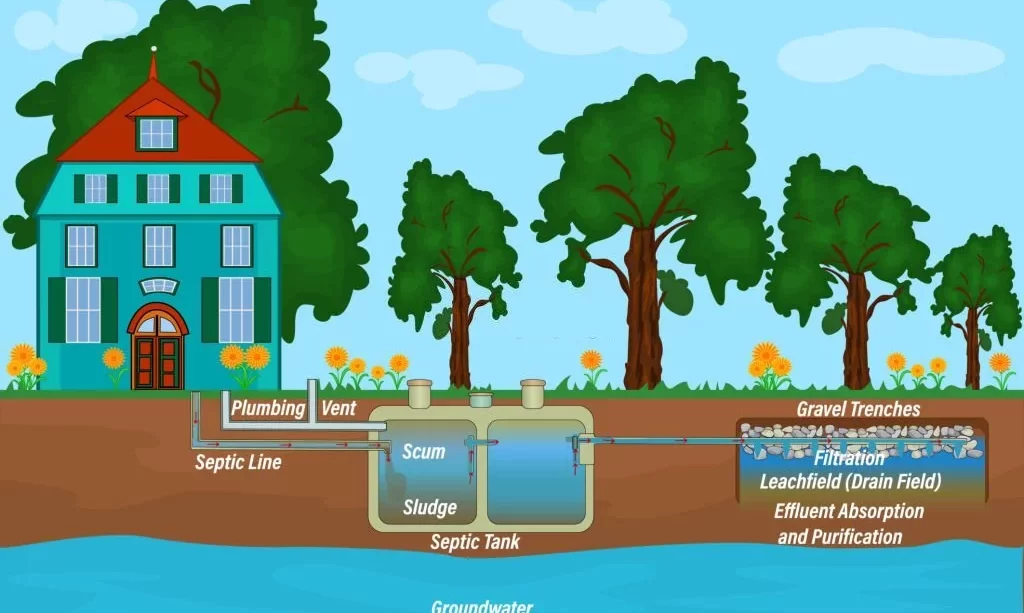Leach fields, often hidden beneath the earth’s surface, play a vital role in the functionality of septic systems. These unsung heroes are responsible for the safe and efficient disposal of wastewater from our homes, ensuring that our daily activities do not disrupt the environment. However, over time, leach fields can encounter issues due to age, clogging, or soil-related challenges. When these problems arise, homeowners face a critical decision: Can a leach field be replaced in the same location? In this article, we will delve into the world of leach fields and explore the possibilities and considerations involved in replacing them in their original spots. Is it a feasible solution, or are there alternative paths to consider? Let’s embark on a journey to uncover the secrets of leach fields and the intricacies of their replacement.
Leach Fields
Before we dive into the prospect of replacing a leach field, it’s essential to grasp the fundamental role that these underground systems play in septic systems:
The Essence of Leach Fields:
- Leach fields, also known as drain fields or absorption fields, are a crucial component of septic systems.
- Their primary purpose is to distribute and treat wastewater that has passed through the septic tank, allowing it to safely percolate into the surrounding soil.
- Leach fields function as natural filtration systems, removing impurities and contaminants from the wastewater before it reenters the groundwater table.
- These underground networks consist of a series of perforated pipes buried in trenches, which facilitate the gradual release of treated effluent into the soil.
Leach fields silently perform their vital duty, ensuring that our homes maintain a harmonious coexistence with nature. However, their significance becomes most apparent when issues arise, prompting us to explore the possibility of replacing them while considering the intricacies involved in the process.
Signs of Leach Field Problems
Recognizing signs of leach field issues is crucial in determining whether replacement is necessary. Here are some common indicators of leach field problems:
Slow Draining Fixtures:
- One of the early signs is slow drainage from sinks, showers, toilets, or other plumbing fixtures in your home.
- Water may take longer to empty, and you might notice gurgling sounds as it drains.
Sewage Odors:
- Unpleasant sewage odors in or around your home can be a clear signal of leach field issues.
- These odors may indicate that the system is not effectively treating and dispersing wastewater.
Wet Spots in the Yard:
- Wet or soggy areas in your yard, particularly near the location of the leach field, can be a visible sign of trouble.
- These spots may result from wastewater surfacing instead of being properly absorbed by the soil.
Backed-Up Drains or Toilets:
- Frequent backups in your plumbing, especially after routine maintenance or pump-outs, can point to a compromised leach field.
Recognizing these signs early is crucial, as prompt attention can prevent further damage to your septic system.
Assessing the Feasibility of Replacing in the Same Spot
Determining whether it’s viable to replace a leach field in the same location requires careful consideration. Here’s what you need to assess:
Soil Conditions:
- The suitability of the existing soil for a new leach field is paramount. Conduct soil testing to ensure it can adequately absorb and treat wastewater.
- Soil permeability, texture, and depth are critical factors to evaluate.
Local Regulations:
- Check local regulations and permits required for septic system work, as they may impact your ability to replace the leach field in the same spot.
- Compliance with environmental and zoning codes is essential.
Extent of Damage:
- Assess the extent of damage or issues affecting the existing leach field. Minor problems may be correctable, while extensive damage might necessitate a full replacement.
Professional Assessment:
- Seek the expertise of a septic system professional to conduct a thorough evaluation of the site. Their insights can help determine the feasibility of replacement.
Steps to Replace a Leach Field in the Same Spot
If replacing the leach field in the same location is deemed feasible, a series of well-defined steps is required for success:
Soil Testing:
- Conduct comprehensive soil testing to assess its suitability for the new leach field. This informs the design and sizing of the system.
Permit Acquisition:
- Obtain the necessary permits and approvals from local authorities to ensure compliance with regulations.
Excavation and Removal:
- Excavate and remove the old leach field components carefully, ensuring proper disposal of any contaminated materials.
New Leach Field Installation:
- Install a new leach field with precision, following design specifications and guidelines for optimal function.
- Properly position and secure the perforated pipes, gravel or stone fill, and distribution box.
Inspection and Testing:
- Have the new system inspected and tested to ensure it meets all regulatory and performance standards.
Backfill and Restoration:
- Carefully backfill the trenches, restoring the site to its original condition or landscaping as desired.
Replacing a leach field in the same spot is a complex process that demands meticulous planning and execution. Seeking the guidance of septic system professionals is highly advisable to ensure a successful replacement that restores the functionality of your septic system.
- KNOW BEFORE YOU GROW | Grow the healthiest, sustainable lawn and garden with the most accurate and easy to use professional soil test kit on the market
- FAST & ACCURATE | Unlike at-home pH meters and test strips, our mail-in professional lab analysis accurately measures 13 plant-available nutrient levels, including Nitrogen and pH. Results in 6-8 days
- FOR ANY GROWING SCENARIO | Tests any soil type and growing condition – lawn & turf, vegetable gardening, flowers, compost, trees, vines, ornamental landscape, house plants, soil-less media or hydroponics
- SAVE TIME & MONEY | Stop applying products you don’t need. Learn exactly what products and amounts you need to grow the healthiest plants possible
- CUSTOM RECOMMENDATIONS | What to apply, how much to apply, and when to apply it. Provides both organic and non-organic fertilizer recommendations to effectively amend your soil
Alternative Solutions
In some cases, replacing a leach field in the same spot may not be the most suitable option. Here are alternative solutions to consider:
Relocating the Leach Field:
- If soil conditions or local regulations prohibit replacement in the same location, relocating the leach field to a more suitable area of your property may be necessary.
- Soil testing and proper design are crucial when considering a new location for the leach field.
Aerobic Treatment Unit (ATU):
- An alternative to traditional leach fields is the installation of an aerobic treatment unit. ATUs use aerobic bacteria to treat wastewater more efficiently.
- They can be installed above ground or below ground, offering flexibility in placement.
Regular Maintenance and Repairs:
- In some cases, leach field issues may be due to minor problems like clogs or damaged pipes. Routine maintenance and repairs can restore functionality without the need for full replacement.
Professional Guidance and DIY Considerations
When faced with leach field problems, it’s essential to make informed decisions about whether to proceed with replacement or consider alternatives:
Professional Guidance:
- Seek the expertise of septic system professionals for a thorough assessment of your situation.
- Professionals can provide valuable insights, recommend the most appropriate solution, and ensure compliance with local regulations.
DIY Considerations:
- While some aspects of septic system work may be suitable for skilled DIYers, it’s crucial to recognize your limitations.
- Certain tasks, such as soil testing, permitting, and system design, are best left to professionals to avoid costly mistakes.
Conclusion
The decision to replace a leach field in the same location or explore alternative solutions is a critical one that requires careful evaluation of various factors. Understanding the signs of leach field problems, assessing the feasibility of replacement, and considering alternative options are all essential steps in the process.
Ultimately, the guidance of septic system professionals is invaluable in making the right choice for your specific circumstances. Whether you opt for replacement, relocation, or an alternative system, the goal is to ensure the efficient and environmentally responsible treatment of wastewater, safeguarding both your property and the surrounding environment. By making informed decisions, you can address leach field issues effectively and maintain the integrity of your septic system.




